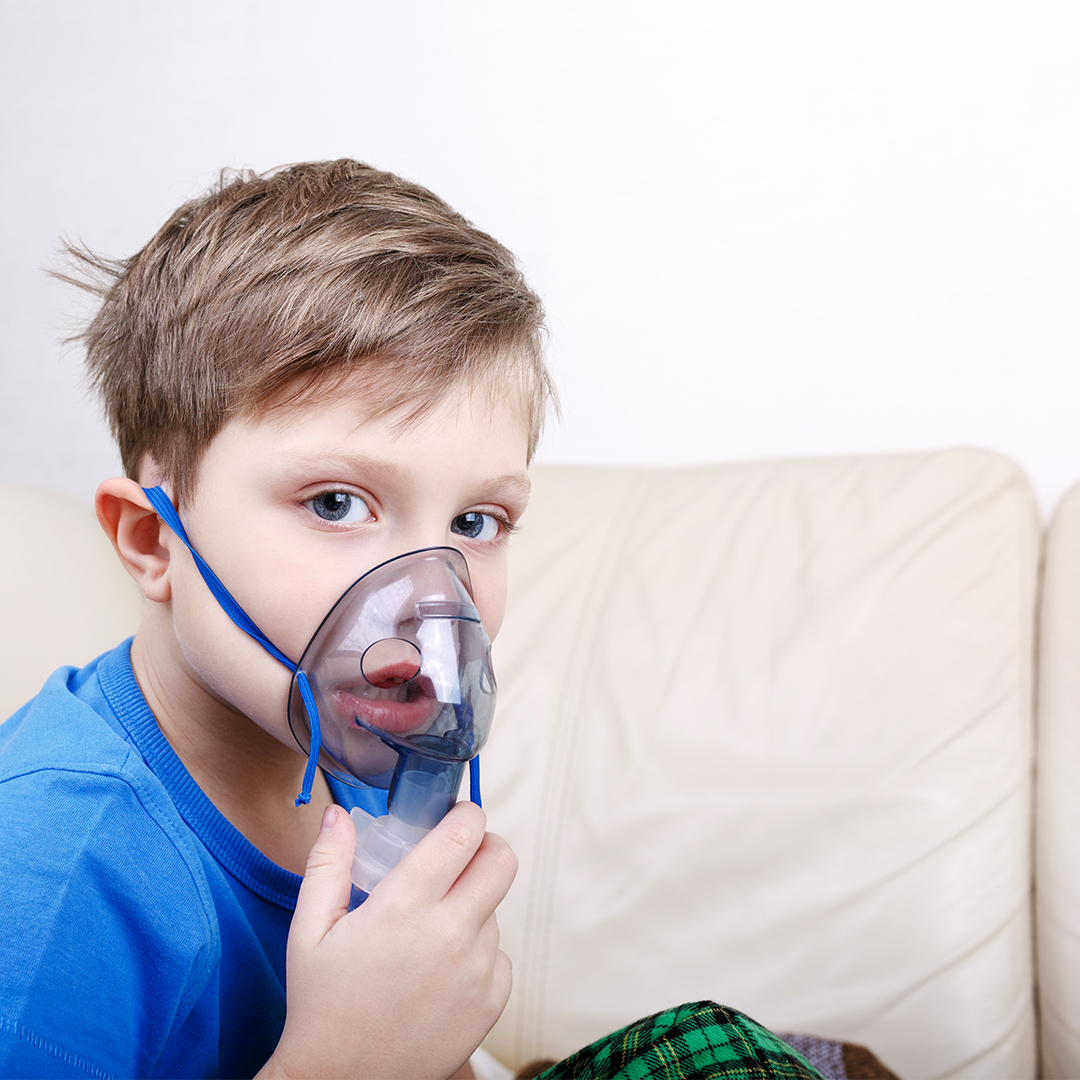Pediatric Asthma
Pediatric Asthma: What Should I Know?
Asthma is a chronic condition with symptoms that may include cough, wheezing, chest tightness or pain, and/or difficulty breathing. These symptoms occur periodically, usually related to specific triggering events. The small airways of people with asthma narrow during these episodes; the narrowing is partially or completely reversible with asthma treatments. In addition, the airways in patients with asthma react to a variety of stimuli, which may include viral illnesses (eg, the common cold), exercise, inhalant or food allergens to which the patient is allergic, or environmental conditions.
Asthma is the most common chronic disease in children in resource-abundant countries, affecting approximately 8 to 12 percent of children who are less than 18 years of age. It is more common in males than females under the age of 15 years. The increasing prevalence previously reported in resource-abundant countries appears to have plateaued or even declined. In resource-limited countries, asthma prevalence is generally increasing, and both severity and mortality are higher than in resource-abundant countries.
Asthma occurs when the small airways (bronchi) in the lungs become inflamed and narrowed, which limits the flow of air out of the lungs. This narrowing is almost always completely reversible with treatment in children. Many different genetic, infectious, and environmental factors may increase the risk of developing asthma, a few of which include: Viral infections – Children who have wheezing with respiratory syncytial virus or rhinovirus seem to be at increased risk for developing asthma. Pollution – Exposure to indoor and outdoor pollution may increase the risk of developing asthma.Exposure to tobacco smoke – Exposure to tobacco smoke during pregnancy and throughout childhood increases the risk of developing asthma.Family history – Children with a personal or family history of certain medical problems, such as asthma, allergies, or eczema, are at increased risk of developing asthma.Stress – Severely negative life events in children increase the risk of asthma attacks over the subsequent few weeks.
However, not all children with asthma have identifiable risk factors. In other words, even children who live in unpolluted areas and whose parents do not smoke or have asthma can develop asthma. It is not clear if there are ways to reduce a child’s risk of developing asthma.
ASTHMA SYMPTOMS
Coughing and wheezing — Symptoms of asthma in children include coughing and wheezing. The cough is usually dry and hacking and is often most noticeable while the child sleeps and during early morning hours. It may also be triggered by exercise or cold air exposure. Wheezing is a high-pitched, musical sound that is usually heard when the child breathes out. It can generally only be heard with a stethoscope.
Coughing and wheezing tend to come and go during the day or night, depending upon the degree of airway narrowing in the lungs. Breathlessness, chest tightness or pressure, and chest pain may also occur. In addition to coughing or wheezing, a child may report that his or her chest or stomach hurts.
Asthma symptoms often develop in children before five years of age, although it is sometimes difficult to diagnose asthma in infants and toddlers. Up to a third of children under three years of age will cough and wheeze with colds, but many of them will not go on to have asthma. Thus, the diagnosis is usually established when the patient continues to have recurrent episodes after turning three years of age. Documentation of reversible obstruction, most often seen during an acute episode, helps to establish the diagnosis.
Asthma triggers — Wheezing and coughing may occur at any time, but certain triggers are known to worsen asthma in many children.
Environmental conditions — Cold air, changes in barometric pressure, rain, or wind may cause increased asthma symptoms in certain people. Pollution, including exhaust fumes and particulate matter, may also induce symptoms.
Upper respiratory infections — Viral upper respiratory infections (head and chest colds) are the most common trigger of asthma in infants and young children. The most common viral infections include rhinovirus (the virus that causes most colds), respiratory syncytial virus, and influenza virus.
Children with asthma should use their asthma treatments for cough and chest congestion rather than over-the-counter cold remedies, which are not effective therapies for asthma.
Exercise — Narrowing of the airways can be triggered by exercise. This is called exercise-induced asthma (also called exercise-induced bronchoconstriction or EIB). Breathlessness, wheeze, and/or cough usually occur within 10 minutes of the cool-down period after vigorous exercise but may occur during exercise. These symptoms tend to disappear after 20 to 45 minutes. Certain types of exercise (eg, swimming) are less likely to cause exercise-induced asthma than others (eg, running, skating), probably because they produce less airway cooling and drying. Short bursts of activity tend to be better tolerated than prolonged exercise. When appropriately treated, children with asthma can participate in sports at any level of competition.
Allergens and irritants — Indoor and outdoor allergens are an important trigger of childhood asthma, particularly for children older than three years of age. In children with seasonal allergies, asthma symptoms may worsen during certain pollen seasons. Symptoms can also flare as a result of mold exposure (eg, during rainy seasons or in damp areas). Indoor pollutants can act as irritants and also trigger asthma symptoms. Irritants and allergens include: House dust (ie, dust mites, cockroaches, mice droppings), particularly during vacuuming. Animal exposures; cats and dogs are especially provocative, but other furry animals (gerbils, rabbits, hamsters, etc) may be suspect, particularly if symptoms only occur in settings where these animals reside. Pollens (the pollen season and types of pollen vary depending upon the region and climate) Molds, Indoor pollutants (eg, paint, perfume, cleaning products, space heaters, gas stoves, room deodorizers), Smoke (tobacco from cigarettes or vaping, wood-burning stoves)
If allergies are a possible cause of symptoms, skin or blood testing may be recommended. This can help to both identify triggers and determine the necessity of avoiding these triggers at home.
Symptom patterns — Children with chronic asthma may have one of several distinct patterns of symptoms, and the asthma pattern may change over time:
- Intermittent asthma attacks with no symptoms between attacks
- Chronic symptoms with intermittent worsening
- Attacks that become more severe or frequent over time
- Morning “dipping,” when symptoms worsen in the morning and improve as the day progresses
- Symptoms that begin during upper respiratory tract infections (eg, colds) and linger for several weeks after, with resolution during warmer weather when respiratory infections are typically less common
Most asthma episodes/exacerbations develop slowly over a period of several days. Uncommonly, a severe attack can occur suddenly, even in someone with intermittent asthma, and with minimal warning.
ASTHMA DIAGNOSIS
The diagnosis of asthma in children requires a careful review of a child’s current and past medical history, family history, and a physical examination. Specialized testing is sometimes needed to diagnose asthma and to rule out other possible causes of symptoms. Many children with asthma appear and sound completely normal between episodes/exacerbations.
Spirometry testing — Spirometry measures the flow and volume of air blown out after a child takes a very deep breath and then forcefully exhales. If airflow obstruction is present, the test may be repeated after the child uses an asthma inhaler or nebulizer (bronchodilator) to confirm that the obstruction is reversible (a feature of asthma).
Children younger than six years sometimes have a hard time following the instructions to perform spirometry. Testing of younger children and infants is described below.
Challenge testing — A bronchial challenge test may be recommended to diagnose asthma. This testing is designed to cause the airways to narrow in children with asthma. The most common challenge tests include inhaling an agent (eg, methacholine) that causes bronchoconstriction, exercise by running on a treadmill or using an exercise cycle, or breathing cold air. Testing is done in a specialized asthma testing center that is capable of providing emergency asthma care if needed.
Additional testing — Other tests may be recommended to ensure that another condition is not the cause of a child’s coughing or wheezing. This may include a chest X-ray, sweat chloride test (for cystic fibrosis), endoscopy of the upper gastrointestinal tract (for gastroesophageal reflux that fails to respond to treatment), modified barium swallow (for aspiration), or skin or blood testing (for allergies or immune problems).
Testing for young children — Infants and children younger than six years are usually not able to reliably perform spirometry or peak expiratory flow rate testing. In some cases, a health care provider may recommend a trial of asthma medication to confirm the diagnosis.









